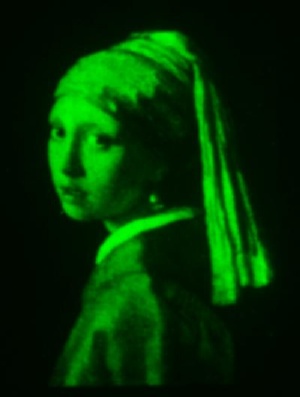Nov 12 2008
Canadian researchers have created a new protein patterning technique that's enabled them to reproduce complex cellular environments and a miniature version of a masterpiece painting. According to a new study published in the journal Lab on a Chip, scientists from Université de Montréal, the Maisonneuve-Rosemont Hospital Research Centre, McGill University and the Montreal Neurological Institute have developed a laser technology that can mimic the protein patterns that surround cells in vivo and that could lead to great advances in neuroscience.
 The research team reproduced the masterwork Girl with a Pearl Earring in the miniature dimension of 200 microns wide or about the thickness of two hairs. Credit: Santiago Costantino, Université de Montréal
The research team reproduced the masterwork Girl with a Pearl Earring in the miniature dimension of 200 microns wide or about the thickness of two hairs. Credit: Santiago Costantino, Université de Montréal
To illustrate the precision of their protein patterning technique, the research team reproduced a masterwork of Dutch painter Johannes Vermeer, specifically Girl with a Pearl Earring, in the miniature dimension of 200 microns wide or about the thickness of two hairs. The researchers also used their novel technology to replicate the brain's complex cellular environment. It's a major discovery, since the new laser technology can encourage and guide the growth of finicky nerve cells.
"We have created a system that can fabricate complex methods to grow cells," says Santiago Costantino, the study's lead author and a scientist at the Université de Montréal and Maisonneuve-Rosemont Hospital Research Centre.
"We see this technique as being very relevant to neuroscience and immunology research. With this system, we laid down a chemical gradient to guide the growth of nerve fiber, which is very useful in studying nerve damage and repair."
Flexible and precise
Using laser-assisted protein adsorption by photobleaching (LAPAP), the scientific team bound fluorescently-tagged molecules to a glass slides and created patterns of proteins similar to those of the human body. They then demonstrated how flexible and precise this technique could be by reproducing a fluorescent micro version of Girl With a Pearl Earring.
"The flexibility, precision and ease of this technique will hopefully lead to increased access in protein patterning, which could lead to major advances in science," says Dr. Costantino, who is also a member of the BioFemtoVision Canadian Research Group, which includes researchers from the Université de Montréal and the Institut National de la Recherche Scientifique who are working on developing new laser technologies for vision science.
"Our next goal is to extend laser-assisted protein adsorption by photobleaching to fabricate more complex protein combinations and distributions," adds Dr. Costantino. "We want to improve our imitation of the chemical environment found in the early stages of developing organisms."